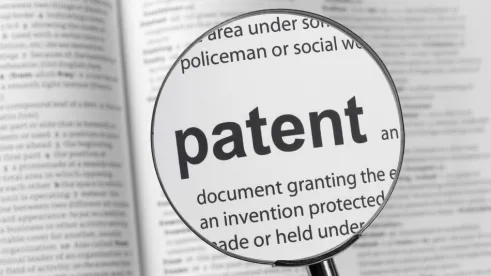Holding: In Indivior UK Ltd. v. Dr. Reddy’s Laboratories S.A., No. 20-2073 (Fed. Cir. 2021), the Federal Circuit issued an opinion (“Majority Opinion”) affirming a decision of the Patent Trial and Appeal Board (“PTAB”) holding all but one of the challenged claims unpatentable in IPR2019-00329. Judge Linn concurred-in-part and dissented-in-part (“Linn Opinion”).
Background: Petitioner, Dr. Reddy’s Laboratories (“DRL”), challenged Claims 1-5 and 7-14 of U.S. Patent No. 9,687,454 (“the ’454 Patent”) on anticipation grounds, citing the pre-grant publication of the original parent application from which the ’454 patent claimed priority. Specifically, DRL asserted that the challenged claims, which issued from a fifth continuation of U.S. Patent Application 12/537,571 (“the ’571 Application”), lacked written description support in the earlier ’571 Application and thus, could not properly obtain the benefit of the ’571 Application’s effective filing date (August 7, 2009). Accordingly, DRL argued that the challenged claims were anticipated by the earlier publication of the ’571 Application on February 10, 2011, as U.S. Patent Publication 2011/0033541 (“the ’541 Publication”).
The ’454 Patent is directed to oral films that are designed to dissolve and release therapeutic agents. Claims 1, 7, 8, and 12 of the ’454 Patent, which the majority highlighted as illustrative of all of the challenged claims, read as follows:
-
An oral, self-supporting mucoadhesive film comprising:
-
about 40 wt % to about 60 wt % of a water-soluble polymeric matrix;
-
about 2 mg to about 16 mg of buprenorphine or a pharmaceutically acceptable salt thereof;
-
about 0.5 mg to about 4 mg of naloxone or a pharmaceutically acceptable salt thereof; and
-
an acidic buffer;
wherein the film is mucoadhesive to the sublingual mucosa or the buccal mucosa;
wherein the weight ratio of (b):(c) is about 4:1;
wherein the weight ratio of (d):(b) is from 2:1 to 1:5; and
wherein application of the film on the sublingual mucosa or the buccal mucosa results in differing absorption between buprenorphine and naloxone, with a buprenorphine Cmax from about 0.624 ng/ml to about 5.638 ng/ml and a buprenorphine AUC from about 5.431 hr*ng/ml to about 56.238 hr*ng/ml; and a naloxone Cmax from about 41.04 pg/ml to about 323.75 pg/ml and a naloxone AUC from about 102.88 hr*pg/ml to about 812.00 hr*pg/ml.
-
7. The film of claim 1, wherein the film comprises about 48.2 wt % to about 58.6 wt % of the water soluble polymeric matrix.
-
8. The film of claim 7, wherein the film comprises about 48.2 wt % of the water soluble polymeric matrix.
-
12. The film of claim 1, wherein the weight ratio of (d):(b) is from about 1:1 to 1:5; wherein the weight ratio of (b):(a) is from about 1:3 to about 1:11.5; and wherein the film comprises about 48.2 wt % to about 58.6 wt % of the water soluble polymeric matrix.
Majority Opinion at *3-4 (emphasis in original).
The ’571 Application, to which the ’454 patent claims priority, included a table disclosing the weight percentages of individual polymeric components in a film sample that, when combined, produced an aggregate polymer weight percentage value of 48.2 wt %. The PTAB held that such disclosure provided adequate written description support for the phrase “about 48.2 wt %” in Claim 8, such that Claim 8 was entitled to obtain the benefit of priority to the ’571 Application’s effective filing date. Therefore, the PTAB held Claim 8 was not anticipated by the ’541 Publication, which published after the ’571 Application’s effective filing date.
However, no other challenged claim fared so well. The PTAB held that Claims 1-5, 7, and 9-14 did not have sufficient written description support in the ‘571 Application and, therefore, were unpatentable as anticipated by the ’541 Publication. According to the PTAB, representative claims 1, 7, and 12 recited ranges of acceptable aggregate polymer weight percentages, but the ’571 Application did not “discuss or refer to bounded or closed ranges of polymer weight percentages.” Majority Opinion at *5. Moreover, the PTAB found that “a person of ordinary skill would have been led away from a particular bounded range by the ’571 application’s teaching that ‘[t]he film may contain any desired level of self-supporting film forming polymer.’” Id. Thus, the PTAB concluded that these claims were not entitled to the benefit of priority to the ’571 Application’s effective filing date, and so ’541 Publication was effective prior art against these claims.
Majority’s Analysis and Conclusion: Judge Lourie, writing for the majority of the Federal Circuit panel, started from the premise that to satisfy the written description requirement for a claimed closed range, “a skilled artisan must be able to reasonably discern a disclosure of that range.” Id. at *9. The majority agreed with the PTAB that there was no written description support in the ’571 application of the ranges recited in Claims 1-5, 7, and 9-14 and, therefore, those claims were unpatentable over the ’541 Publication. Id. at *8.
In reaching this decision, the majority highlighted the fact that the ’571 Application explicitly recited neither (1) the ranges recited in Claim 1 (40 wt % to 60 wt %) and Claims 7 and 12 (48.2 wt % to 58.6 wt %); nor (2) for the range recited in Claim 1, the end values of said range (i.e., 40 wt % and 60 wt %). Id. The majority acknowledged that Tables 1 and 5 of the ’571 Application disclosed weight percentages of individual polymer components in samples that, when identified and pooled, yielded specific and discrete examples of aggregate polymer weight percentages (i.e., 48.2 wt % and 58.6 wt %) falling within the claimed ranges. Id. at 9-10. But, according to the majority, that disclosure was not sufficient to provide written description support of the claimed ranges because it does not show sufficient possession if a skilled artisan has to “cobbl[e] together [these] numbers after the fact.” Id. at 10. According to the majority, such a standard would amount to nothing more than “an invitation to go on a hunting expedition to patch together after the fact a synthetic definition of an invention.” Id.
Additionally, the majority pointed to the ’571 Application’s statement that “any desired level of . . . polymer” could be used in the film, and its disclosure of embodiments of polymer weight percentages falling outside of the claimed ranges (e.g., “at least 25[ wt ]%”), and noted that these disclosures would lead a skilled artisan away from the conclusion “that the inventor had possession of the claimed subject matter as of the filing date.” Id. at *9 (quoting Ariad Pharms., Inc. v. Eli Lilly & Co., 598 F.3d 1336, 1351 (Fed. Cir. 2010) (en banc)).
Finally, the majority rejected Indivior’s arguments relying on Nalpropion Pharmaceuticals, Inc. v. Actavis Laboratories FL, Inc., 934 F.3d 1344 (Fed. Cir. 2019) and In re Wertheim, 541 F.2d 257 (C.C.P.A. 1976), noting that “written description cases are intensively fact-oriented” (id. at *10-11) and “[b]roadly articulated rules are particularly inappropriate in this area” (id. at *11 (quoting Wertheim, 541 F2d at 263)). The majority noted that “no case, with necessarily varied facts, controls the resolution of the written description issue in this case.” Id. Accordingly, the majority held that the PTAB properly concluded that Claims 1-5, 7, and 9-14 lacked written description support in the ’571 Application, and thus they were anticipated by the ’541 Publication. Id.
As for Claim 8, which recited a discrete polymeric weight percentage limitation (“about 48.2 wt %”), the majority deferred to the PTAB’s finding that a skilled artisan could readily determine—by identifying and summing the individual weight percentages of various polymers in the sample films—that Tables 1 and 5 in the ’571 Application provided adequate written description support for the claimed polymeric weight percentage. Id. at *12. The majority reconciled any seeming inconsistency between this holding and its holding regarding the other challenged claims by noting the differences between reciting a range and “a specific amount.” Id. With the benefit of the earlier priority date, the majority affirmed that DRL’s anticipation challenge to Claim 8 failed. Id.
Judge Linn’s Opinion: Judge Linn disagreed with the majority over the application of the Wertheim and Nalpropion case law and the resulting conclusion that the claims reciting ranges were anticipated because they did not have written description support in the priority ’571 Application. Judge Linn considered “both cases directly on point” and inconsistent with the majority’s conclusions for claims 1-5, 7, and 9-14. Linn Opinion at *4.
Judge Linn also objected to the majority’s analysis of the statement in the ’571 Application that “[t]he film may contain any desired level of … polymer[.]” Id. at *2. When read in context, Judge Linn understood the paragraph to “explicitly identif[y] the essential desired characteristics possessed by the films of the claimed invention and identif[y] the polymer levels needed to impart those characteristics.” Id. The claimed polymer ranges “are selections of aggregate polymer ranges that a reasonable artisan would understand endow the film with the identified and desired properties.” Id. at *3 (emphasis in original).
Judge Linn found no authority for the majority’s position that “written description support for a ‘closed range’ requires a disclosure of a closed range rather than discrete values.” Id. Judge Linn also considered the majority’s reading of the polymer percentage levels in the ’571 Application tables to be erroneous. No “cobbling together” was required and adding up values to meet a desired disclosed characteristic was not beyond the capability of a person of ordinary skill in the art. Id. at *4.
Takeaways: This case appears, for all intents and purposes, to be a modern rehashing of the written description issue in Wertheim, but with a different outcome (although even in Wertheim, the claim reciting “a higher solids level of at least 35%” was found to lack written description support). What led to the different outcome in this case for all claims except Claim 8 appeared to be that the majority did not address the long-standing principle from In re Lukach, 442 F.2d 967 (C.C.P.A. 1971), and applied in Wertheim, that “the invention claimed does not have to be described in ipsis verbis in order to satisfy the description requirement of § 112.” Thus, through this decision, the majority seems to have significantly tightened the written description requirement for claims of closed ranges by demanding explicit disclosure of (possibly identical) closed ranges in the specification. And the majority did so even though it acknowledged the statement from Wertheim that “[b]roadly articulated rules are particularly inappropriate in this area.”
But the Patentee did convince one CAFC judge that Wertheim should have applied to uphold all of the claims, so it will be interesting to see whether other panels follow the majority’s apparently stricter written description support requirement for ranges in future cases.
A more subtle, but perhaps more pressing issue raised by this case is the status of the Federal Circuit’s treatment of precedent from the Court of Customs and Patent Appeals (CCPA). Despite its decision to treat CCPA cases as binding authority in South Corporation v. United States, 690 F.2d 1368, 1369 (Fed. Cir. 1982), the Indivior opinion provides some basis to believe that the weight of these CCPA cases is diminishing. After all, the “youngest” of the CCPA cases is now almost forty years old. This will be a very interesting issue to watch as the years roll on.
Despite all this uncertainty, this case presents us with a stark reminder that a given disclosure may be enough to anticipate a claim even when it is insufficient to establish written description for the same claim.




 />i
/>i

